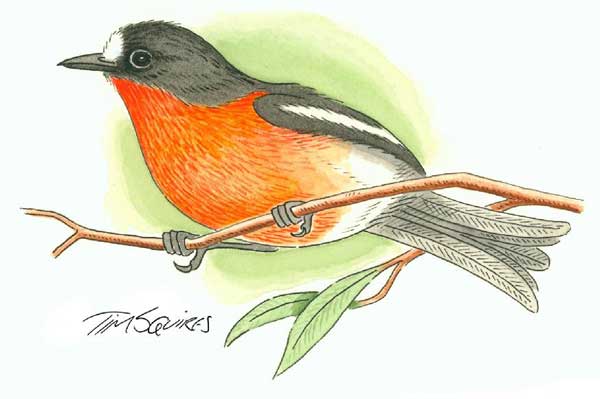 As fleeting and fragile as a snowflake, the tiny flame robin flitted across the summit of Mr Wellington, singing a sweet melody as it went.
As fleeting and fragile as a snowflake, the tiny flame robin flitted across the summit of Mr Wellington, singing a sweet melody as it went.
In an instant it was gone, vanishing as fast as it had first been carried on the wind, its song lost to a snow drift piled high against the rocks, the soft snow swallowing the merry twitter.
The rugged, unforgiving mountain peak is not home to sweet birdsong during the winter months, ringing instead with the harsh sound of the raven’s caw and the mountain currawong’s lament. All the same I had defied reason to travel the Pinnacle Road looking for the first of the spring migrants, those that also defy reason and arrive in Tasmania when snow still lingers in the high country.
It was a long shot but I had a specific bird in mind, the beautiful flame robin which I had glimpsed fleetingly in the lowlands of Richmond a few days previously, in the last week of winter before spring officially made its appearance on the calendar.
I’d seen a single flame robin on the mountain in the past and I thought that if I was to see flame robins, and possibly other early arrivals like the striated pardalote, a slow drive from Fern Tree to the upper slopes of the peak might be the place to find them.
Such hunches rarely work for me, but on this occasion I was to surprise myself.
I had only been out of my car at the summit car park for a few minutes when I heard the flame robin’s song and I immediately went in search of it.
It wasn’t hard to find. There it was on the northern side of the mountain, its delicate beauty set against the backdrop of the peaks of the Tasmanian Wilderness World Heritage Area, the distant mountains brushed with snow.
The flame robin is the only one of the four family members found in Tasmania that goes north over Bass Strait for the winter and each year I eagerly await their return. The scarlet robin that lights up our suburbs during the winter months might also be a stunner, but the male flame robin has a different, more subtle kind of beauty. Its breast is not scarlet red but more of a fiery orange and this alone sets it apart from its near relative. But on closer observation the flame robin has an orange throat, the colour of the breast reaching right up to the chin; the scarlet robin has a black throat. The flame also has a charcoal-grey head and back, the scarlet has a black head and back.
The females of both species have grey heads and backs but the flame robin has only a faint trace of colour on the breast, while the female scarlet has a prominent red breast, although not as striking as the male’s.
I lingered on the mountain summit and cast my eyes north from where the flame robin had come. The green valleys meandering between the mountains and lower hills stretched into the distance before they were lost in mist and low cloud and I pictured all the other birds on their way, following ancient trails that lead them to their breeding rounds. Somewhere out there were summerbirds, welcome and dusky swallows, tree martins, fan-tailed and pallid cuckoos.
I didn’t immediately see the flame robin again and I thought that it might still be travelling, heading further south with the mountain merely another obstacle in its way. He soon started singing again, however, and was clearly establishing his summer territory with its cheerful and optimistic tune in what would soon be a less hostile world. For this tiny bird the long, perilous migratory journey was over, at least until the autumn.